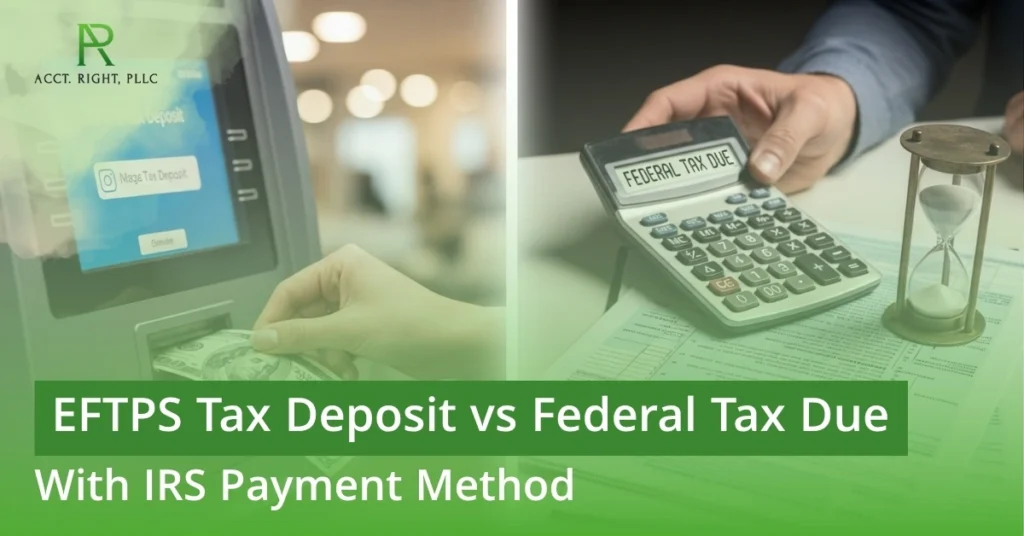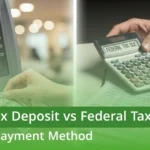
Want to understand EFTPS Tax Deposit vs Federal Tax Due with financial experts? You are in the right place. When it comes to managing your tax obligations, understanding the difference between EFTPS tax deposits and federal tax due is crucial that you think. Many taxpayers, including individuals, small business owners, or corporations, often confuse these terms. Poor understanding can lead to late payments, penalties, or reconciliation errors. Financial experts come to this field to resolve all related problems and help clients navigate these complex tax processes with simple, easy-to-handle steps.
In this comprehensive guide, experts of Acct Right cover everything from how EFTPS works to tax liability management, IRS guidelines, and practical tips for avoiding common mistakes based on their expertise in this field.
What is EFTPS? A Complete Overview
Basic one, but important. The Electronic Federal Tax Payment System (EFTPS) refers to an online prepayment system used by businesses and individuals to deposit federal taxes electronically via the Electronic Federal Tax Payment System (EFTPS) before the due date.
Key Features of EFTPS:
- 24/7 Access: You can pay anytime, anywhere on your computer or phone.
- Secure Transactions: Multi-layer security is used to enable safe processing of payments.
- Scheduled Payments: It is possible to schedule payments, up to 365 days in case of individuals and up to 120 days in case of businesses.
- Payment Tracking: You can also track and follow your payment history at all times.
- Large assortment of Payments: Accepts income taxes, employment taxes, excise taxes, and others.
Expert Insight:
According to Tom Brock, Financial advisor, “EFTPS is ideal for managing multiple payments, scheduling in advance, and keeping an accurate record of all federal tax deposits. It helps prevent late payments and simplifies compliance for both individuals and businesses.”
What is Federal Tax Due? Understanding the Basics
Unlike an EFTPS tax deposit, which is a payment method, federal tax due refers to the total amount of taxes owed to the IRS after considering withholding, prepayments, and credits. It represents your calculated tax liability at the time of filing
Components of Federal Tax Due:
- Total Tax Liability: The complete tax owed based on income, deductions, and credits.
- Prepayments: Includes wage withholding, estimated taxes, and refundable credits.
- Balance Due: The remaining amount after subtracting prepayments from total tax liability.
A client of AcctRight shared their experience with us:
“I was confused between my EFTPS payments and what I actually owed. After consulting with the AcctRight team, I finally understood the difference and realized I had overpaid a quarter. The system reflected the correction immediately. Thanks to their guidance, I now always double-check my federal tax due before submitting EFTPS payments.”
Key Differences of EFTPS Tax Deposit and Federal Tax Due
Understanding the distinction is crucial to avoid underpayment, overpayment, or penalties.
| Aspect | EFTPS Tax Deposit | Federal Tax Due |
| Definition | Payment made to the IRS using EFTPS | Amount owed after calculating tax liability |
| Purpose | Fulfills tax obligations | Represents the balance owed to the IRS |
| Timing | Can be scheduled in advance | Determined at the time of filing |
| Frequency | One-time or recurring payments | Usually annual, based on the tax year |
| Method | Electronic payment | Determined through tax return calculations |
Understanding the difference between EFTPS deposits and your actual federal tax due can help prevent payment errors and confusion during tax season. For a detailed overview of how tax payments and extensions work, check out our related article on IRS Form 7004 Instructions.
How EFTPS Payments Work
EFTPS is also user-friendly, and a step-by-step guide to the system will ensure payments are accurate.
Simple Steps to Make EFTPS Payments:
- Register in EFTPS: Register at the official EFTPS site.
- Log in (IRS EFTPS Login): Access your dashboard securely.
- Schedule Your Pay: Choose type, amount, and date of payment.
- Confirm Payment: Check the payment and record the confirmation number.
- Watch History of Payments: Keep a history of previous deposits.
Tips: It is common in business to have several recurrent payments so as to avoid late deposit and penalty.

EFTPS vs Traditional IRS Payment Methods: Which One is Best
While EFTPS is a reliable method, other IRS payment options exist, such as:
- Direct Pay via IRS Website: One-time payment from a checking or savings account.
- Credit/Debit Card Payments: Convenient but often include processing fees.
- Paper Checks or Money Orders: Slower and less secure compared to EFTPS.
Why EFTPS Stands Out:
- Secure and encrypted transactions
- Detailed payment history
- Advanced scheduling to match tax due dates
- No additional fees for federal tax deposits
Strategies for Effective Tax Liability Management
Managing your tax liability is more than just paying on time. Strategies include:
- Scheduling Payments in Advance: Align EFTPS deposits with estimated tax due dates.
- Tracking Prepayments: Subtract estimated payments or withholding before calculating the final federal tax due.
- Consulting Professionals: CPAs or tax advisors of AcctRight Pllc. can help optimise your payment schedule.
- Maintaining Accurate Records: Keep copies of all EFTPS confirmations and tax return filings.
Benefits of EFTPS for Individuals and Businesses
- Convenience: Pay anytime wherever you are as long as there is access to the internet.
- Security: Multi-factor authentication will minimize fraud.
- Control: Schedule and amend payments prior to its being processed.
- Record-Keeping: Access to payment history and confirmation numbers is easily accessible.
- Penalty Avoidance: Timely payments assist in avoiding late payment and interest.
Conclusion
Making the distinction between the EFTPS tax deposit and federal tax due is of paramount importance in preventing errors and remaining in line with the IRS. Although EFTPS provides a secure and convenient method of paying taxes, the amount of federal tax due is the portion of the amount of tax that has to be paid after considering the amount of prepayment and credits. Knowing these differences, application of EFTPS and seeking professional tax advice where necessary can enable a taxpayer to simplify the process of tax process, reduce risks, and maintain proper compliance.
At Acct. Right, PLLC, we help clients reconcile payments, avoid errors, and manage tax liability effectively. Don’t let confusion over EFTPS payments affect your finances. Schedule a consultation today and take control of your tax obligations.
Frequently Asked Questions
What is an EFTPS federal tax deposit?
EFTPS is the IRS’s secure online system to pay federal taxes electronically.
Is it better to use IRS Direct Pay or EFTPS?
Direct Pay is easiest for individuals; EFTPS is better for businesses or scheduled payments.
What does “Federal Due” on a tax return mean?
It’s the amount of federal tax you still owe after subtracting payments or withholding.
How can I deposit federal taxes without EFTPS?
Use IRS Direct Pay, a credit/debit card, or mail a check with Form 1040-V.
Can I make a same-day EFTPS payment?
Yes, but it must be scheduled before 8:00 PM ET on the same day for processing.
What if my EFTPS payment fails?
You’ll receive an error message. Review bank details and reschedule. Contact Acct. Right, PLLC for assistance.
Is EFTPS mandatory?
Not for all taxpayers, but businesses and corporations with certain liabilities are required to use EFTPS.




